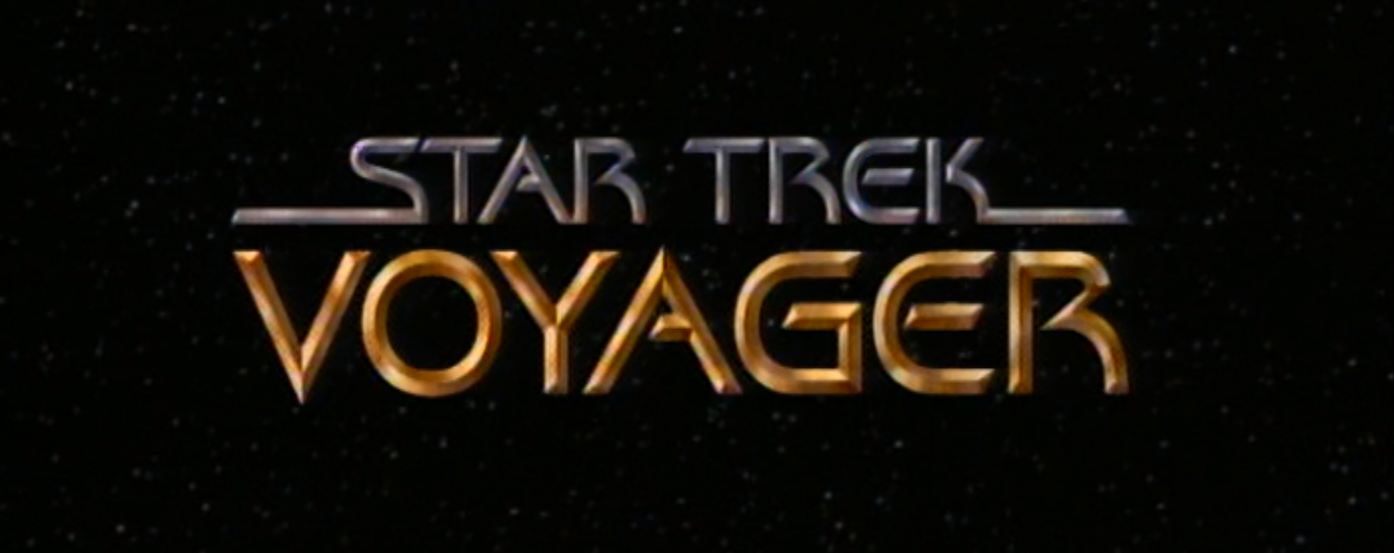
Hello and welcome as always to ‘Final Frontier Friday.’ This week I’ll be continuing my quest to focus on things that aren’t the original ‘Star Trek’ or ‘The Next Generation’ by tackling an episode of ‘Voyager’. In fact, for some of you, ‘Threshold’ may very well be “that episode” of ‘Voyager’. Suffice to say, last time I was to some extent taking up the defense of an unpopular (or at least divisive) character in Ezri Dax. But I’d be shocked, if anything, if I had to say about ‘Threshold’ was terribly controversial.
‘Threshold’ originated when Brannon Braga and Ronald D. Moore approached Michael De Luca (then head of New Line Cinema and a self-professed Trekkie) about writing an episode. De Luca pitched the story, which was then scripted by Braga. Braga, who describes the episode as a tribute of sorts to the David Cronenberg version of ‘The Fly’, heavily revised the script before production, with some assistance from Paris actor Robert Duncan McNeill. McNeill, who by his own admission, was never quite sure what to make of the script and was instrumental in shaping its conclusion.
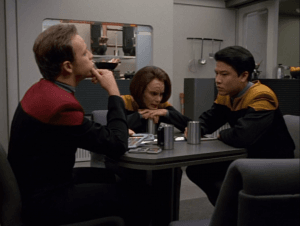
As co-creator and showrunner Jeri Taylor explained, the core of the episode rested on the notion of breaking one of the rules Roddenberry laid out in the early ‘Next Generation’ days and dealing with the consequences of that. It’s easy to see the appeal of a hook like that, especially to the people who have been following those rules for (at the time) the better part of a decade. But at the end of the day, even the most compelling concept is only as good as its execution. So what about that execution?
Well…
We open on Tom Paris. He’s testing an experimental trans-warp drive. Though at first, it seems promising but things take a left turn as he approaches the trans-warp threshold and the shuttle flies apart. Of course, he’s in a holodeck, his frustration evident as he sits on the floor where once there was a simulated shuttle.
 In the mess hall, Paris, Torres, and Kim puzzle over the technical obstacles they’re facing. When Neelix asks what they’re working on, the trio explains that they’re trying to find a way to break the maximum warp barrier. Doing so would allow them to reach warp ten, a theoretical impossibility that would allow travel at infinite velocity. Suffice to say, this would cut the length of Voyager’s journey home from decades down to moments. While explaining the problem – every simulation ends with a nacelle being ripped off an accelerating shuttle – Paris and Kim realize that they’ve got the problem backwards. The nacelles aren’t being ripped from the shuttle by external stresses, the shuttle itself is traveling faster than the nacelles. Realizing that they can compensate for this, the two excitedly return to the holodeck where they finally complete a successful simulation. Results in hand, Janeway agrees to proceed with a manned test flight with Paris at the helm of the aptly named shuttle Cochrane. It’s a resounding success until the shuttle disappears from sensor readings.
In the mess hall, Paris, Torres, and Kim puzzle over the technical obstacles they’re facing. When Neelix asks what they’re working on, the trio explains that they’re trying to find a way to break the maximum warp barrier. Doing so would allow them to reach warp ten, a theoretical impossibility that would allow travel at infinite velocity. Suffice to say, this would cut the length of Voyager’s journey home from decades down to moments. While explaining the problem – every simulation ends with a nacelle being ripped off an accelerating shuttle – Paris and Kim realize that they’ve got the problem backwards. The nacelles aren’t being ripped from the shuttle by external stresses, the shuttle itself is traveling faster than the nacelles. Realizing that they can compensate for this, the two excitedly return to the holodeck where they finally complete a successful simulation. Results in hand, Janeway agrees to proceed with a manned test flight with Paris at the helm of the aptly named shuttle Cochrane. It’s a resounding success until the shuttle disappears from sensor readings.
As the crew scrambles to figure out what happened to the Cochrane, the shuttle emerges from subspace and an apparently sleeping Paris is beamed directly to sickbay. A bewildered Paris awakes and describes the experience of being “everywhere,” even as the memory begins to fade. In engineering, Janeway and Torres begin to review the shuttle telemetry and are in awe at the sheer volume of information as the captain begins to realize the implications of this technology, not just for Voyager but for the Federation. Later, Paris and Torres brainstorm in the mess hall. Neelix brings them a new coffee blend that he has devised and named in Paris’s honor. Unfortunately, the man of the hour can’t stand the stuff, though it doesn’t bother Torres. Soon after, Paris collapses.
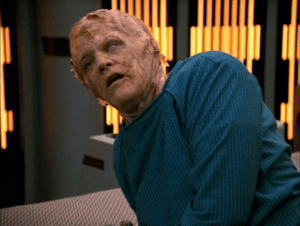 In sickbay, the Doctor determines that Paris suffered an allergic reaction to the water in the coffee, of all things. It seems his entire biochemistry is in flux, a problem which quickly begins to affect his lungs. The Doctor deduced that these changes are a result of the trans-warp flight and does what he can to slow them down while keeping up with those that have already occurred. Unfortunately, there’s only so much he can do, and Paris dies. Later that night, the Doctor finds Paris inexplicably alive – and in possession of an extra heart.
In sickbay, the Doctor determines that Paris suffered an allergic reaction to the water in the coffee, of all things. It seems his entire biochemistry is in flux, a problem which quickly begins to affect his lungs. The Doctor deduced that these changes are a result of the trans-warp flight and does what he can to slow them down while keeping up with those that have already occurred. Unfortunately, there’s only so much he can do, and Paris dies. Later that night, the Doctor finds Paris inexplicably alive – and in possession of an extra heart.
Paris’s mutations continue to accelerate beyond the Doctor’s ability keep up with exactly what they are. They’ve also begun to affect his personality. As he continues to change, he begs to be let off the ship. The Doctor devises an extremely risky method of restoring Paris’s original genetic coding. During the procedure, however, Paris is able to break free. Continuing to mutate, he kidnaps Janeway and flees aboard the Cochrane. At warp ten.
Eventually, they manage to track the Cochrane to its destination. While en route, the Doctor identifies a pattern in Paris’s mutation that corresponds to human evolutionary history. Chakotay leads an away team to the shuttle’s landing site, where they find two oversized salamanders – Paris and Janeway, hyper-evolved. After stunning the two, the team notices a handful of smaller creatures. Their offspring, which Chakotay elects to leave in their new habitat. Back on Voyager, the Doctor is able to restore the two to normal.
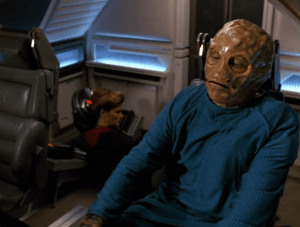
So that’s a thing that happened.
To recap, extreme physical acceleration also somehow accelerates evolution. And instead of being a series of random mutations accumulating over the eons, evolution apparently follows a set path. Oh, and that path leads directly from mid-sized primate to big salamander.
Okay.
So why did I just inflict that on myself? Well frankly, my last column came close to breaking the record for longest ‘Final Frontier Friday’ (a record still held – by a margin of about two hundred words – by my review of the two-part premiere of ‘Star Trek: Discovery’), so this time out I wanted to have some fun. And covering this one is fun, if only because I’m used to covering good episodes (not entirely by accident).
Now, you’ve followed this column over the past year, you know that I tend to see the positives in ‘Star Trek’, even in episodes where others may not. You might even say I’m a forgiving fan (at least up to a point). But even I find ‘Threshold’ hard to love. The thing about this is that all bad installments are not created equal. ‘Code of Honor‘, for example, is just fundamentally wrong-headed on every level. By contrast, something like ‘The Way to Eden’ is anything but a classic, but it’s not without its goofy charm.
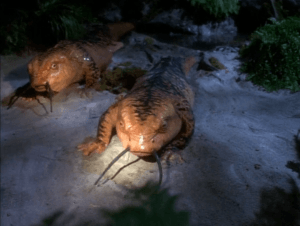
In fact, more than anything, I would say that the episode ‘Threshold’ most resembles ‘Wolf in the Fold‘, in that right up to the moment that Paris collapses in the mess hall, this legendarily bad episode actually isn’t all that bad. In fact, among its few saving graces is the fact that it actually makes for a pretty decent Paris episode, particularly when he’s doing his Chuck Yeager thing. I said earlier that Robert McNeill has never quite been sure what to make of this episode, and as he explains it, that’s a combination of “What the hell did I just read?!” and “This actually does some neat stuff with my character.” And he’s not wrong. Coming as early as it does in the series (the mid-second season), it offers an important early glimpse into Paris’s head (particularly the scene in which he explains his need to prove himself). It’s only when we get into the “beloved mutant” phase of the story that things begin to take a turn for the ridiculous. And boy does it get ridiculous.
So what’s your take on ‘Threshold’? Is there some redeeming value (beyond Paris and the cheesy “Look how ridiculous this is!” factor) that I’ve missed? Let me know in the comments, and as always, be sure to check back in two weeks for the next ‘Final Frontier Friday’!
